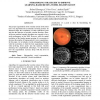Free Online Productivity Tools
i2Speak
i2Symbol
i2OCR
iTex2Img
iWeb2Print
iWeb2Shot
i2Type
iPdf2Split
iPdf2Merge
i2Bopomofo
i2Arabic
i2Style
i2Image
i2PDF
iLatex2Rtf
Sci2ools
ICIP
2009
IEEE
2009
IEEE
Subsampling strategies to improve learning-based retina vessel segmentation
The proper segmentation of the vascular system of the retina has a very important role in automatic screening systems. Its detection helps the localization of other anatomical parts and also the detection of possible vascular disorders. Stateof-the-art machine learning algorithms are reported to have good performance in this field. However, with the spatial resolution of the fundus images growing, it is necessary to decrease the number of training pixels to save computations. In this paper, we investigate several subsampling strategies with the motivation to find the best segmentation results with involving fewer pixels into the analyses. Besides checking the computational advantages, we demonstrate how the segmentation accuracy drops with the level of subsampling.
Automatic Screening Systems | ICIP 2009 | Image Processing | Possible Vascular Disorders | Proper Segmentation |
| Added | 19 Feb 2011 |
| Updated | 19 Feb 2011 |
| Type | Journal |
| Year | 2009 |
| Where | ICIP |
| Authors | Roland Harangozo, Peter Veres, Andras Hajdu |
Comments (0)

